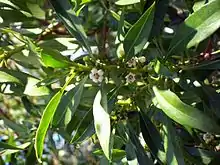| Myoporum acuminatum | |
|---|---|
 | |
| Myoporum acuminatum in the Batemans Bay botanic garden | |
| Scientific classification | |
| Kingdom: | Plantae |
| Clade: | Tracheophytes |
| Clade: | Angiosperms |
| Clade: | Eudicots |
| Clade: | Asterids |
| Order: | Lamiales |
| Family: | Scrophulariaceae |
| Genus: | Myoporum |
| Species: | M. acuminatum |
| Binomial name | |
| Myoporum acuminatum | |
Myoporum acuminatum, commonly known as waterbush, pointed boobialla or mangrove boobialla,[1] is a flowering plant in the figwort family Scrophulariaceae and is endemic to eastern Australia. It grows in rainforest or wet eucalyptus forest near the coast and in the Coastal Ranges, and is occasionally associated with mangroves. Occasionally it is found in the drier rainforests. It grows naturally as far south as Mimosa Rocks National Park in far south eastern New South Wales, and north to Fraser Island in Southern Queensland.[2]
Description
Myoporum acuminatum grows as a hairless shrub or small tree, up to 13 metres (40 ft) tall and a trunk diameter of 50 cm (20 in). In larger plants the trunk may be irregular in shape with flanges. Bark is greyish brown and somewhat wrinkled in larger trees. Small branches are green and fairly thick, though smooth.[1]
M. acuminatum has been considered by some authors to encompass Myoporum montanum.[2] The two species are closely and related and M. montanum has an overlapping range. The common name Waterbush is originally derived from M. montanum, which grows throughout arid central Australia as well as coastal regions, and whose presence is thought to be indicative of groundwater.[3]
The species are difficult to distinguish, being closely related with an overlapping range. M. montanum has smaller, narrower leaves, the flower sepals of M. montanum lack the translucent margins of M. acuminatum and the fruit of M. montanum is pink or light purple compared with the dark purple or blue fruit of M. acuminatum.
Leaves
Leaves are 5 to 14 cm long and 7 to 28 mm wide[4] with a fine point, though rarely seen with a rounded end. The base of the leaf becomes thin near the leaf stem, which measures 6 to 20 mm long. Leaf edges may be finely toothed, or smooth. Leaves lack stipules. Oil dots of varying sizes may be seen under a magnifying lens, of a distance apart of 3 to 5 diameters. Only the midrib is easily seen, other lateral or net veins are obscure.[1]
Flowers and fruit
Flowers appear from May to August, though later in the southern parts of its range. Flowers feature five white petals, with four rows of purple spots and a sweet scent. They grow in clusters from the leaf axils.[1]
The fruit is a roughened, wrinkled drupe. Globular in shape, 5 mm in diameter, dark blue or dark purple in colour. Remnants of the flower style point out of the fruit, 3 to 4 mm long and hooked. Inside are two to four seeds, maturing from October to February.[1][2]
Taxonomy
The plant first appeared in scientific literature in Prodromus Florae Novae Hollandiae in 1810, authored by Robert Brown.[5][6] The genus name Myoporum refers to the Ancient Greek roots myein meaning "to shut" or "to close" and πόρος (poros) meaning "opening" or "pore"[7] referring to the closed glands which appear as transparent spots on the leaves, flowers and fruits.[8] The specific epithet (acuminatum) is a Latin word meaning "tapering to a prolonged point".[9][2]
Distribution and habitat
Myoporum acuminatum grows in rainforest or eucalyptus forest of eastern Australia, from Queensland to the far south coast of New South Wales.[4]
Use in horticulture
Waterbush is a hardy plant in cultivation and can tolerate salt spray. It prefers well drained soil in full sun and is most easily propagated from cuttings.[10]
References
- 1 2 3 4 5 Floyd, A. G. (2008). Rainforest Trees of Mainland South-eastern Australia (2nd, Revised ed.). Lismore, New South Wales: Terania Rainforest Publishing. p. 412. ISBN 978-0-958943-67-3. Retrieved 2010-09-14.
- 1 2 3 4 Chinnock, R.J. 2007 "Eremophila and Allied Genera: A Monograph of the Plant Family Myoporaceae". The Botanic Gardens and State Herbarium of South Australia. Adelaide.
- ↑ "myoporum montanum western boobialla". www.australianseed.com. Archived from the original on 2013-01-17.
- 1 2 "Myoporum acuminatum". PlantNET - NSW Flora Online. Retrieved 2010-09-14.
- ↑ "Myoporum acuminatum R.Br". Australian Plant Name Index (APNI), IBIS database. Centre for Plant Biodiversity Research, Australian Government.
- ↑ Brown, Robert (1810). Prodromus Florae Novae Hollandiae. London. p. 515. Retrieved 11 March 2018.
- ↑ Quattrocchi, Umberto (1999). CRC world dictionary of plant names : common names, scientific names, eponyms, synonyms, and etymology (Volume III; M-Q). Boca Raton, FL: CRC Press. p. 1752. ISBN 0849326737. Retrieved 31 August 2015.
- ↑ Chinnock, R.J. (2007). Eremophila and allied genera : a monograph of the plant family Myoporaceae (1st ed.). Dural, NSW: Rosenberg. p. 95. ISBN 9781877058165. Retrieved 31 August 2015.
- ↑ Francis Aubie Sharr (2019). Western Australian Plant Names and their Meanings. Kardinya, Western Australia: Four Gables Press. p. 127. ISBN 9780958034180.
- ↑ Wrigley, John W.; Fagg, Murray (1983). Australian native plants : a manual for their propagation, cultivation and use in landscaping (2nd ed.). Sydney: Collins. p. 271. ISBN 0002165759.